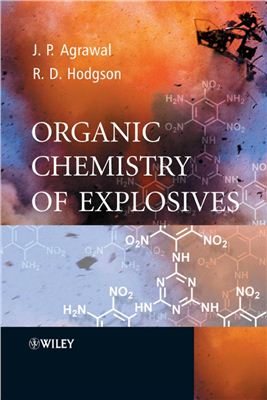John Wiley & Sons Ltd, 2007. – 384 p.
In the past a significant amount of research worldwide was directed at the synthesis of new energetic compounds as potential explosives or propellant ingredients. This research involved the synthesis of many different classes of energetic compounds, including heterocycles, nitrohydrocarbons,
nitrate esters, nitramines and caged compounds. The research in this area has been reviewed many times in the past but these reviews usually concentrated on one class of energetic compounds, e.g. nitroalkenes or nitroazoles, and except for possibly Urbanski’s volumes on the Chemistry and Technology of Explosives (http://www.twirpx.com/file/335016/), a comprehensive study of energetic compound synthesis has not been undertaken.
The Organic Chemistry of Explosives by J. P. Agrawal and R. D. Hodgson is a comprehensive study of the various methods to synthesize the different classes of energetic compounds along with methods to synthesize the various explosophoric groups that predominate the field. It is intended to read like a tutorial on energetic compound synthesis, providing a historical perspective of the various synthetic methods used for energetic compound synthesis, along with enough details and discussion to understand the nuances of energetic compound synthesis.
The Organic Chemistry of Explosives also provides a perspective on the possible applications of various energetic compounds, why they are interesting as explosives or propellant ingredients, and what advantages and disadvantages they might have compared to other energetic compounds. Finally, it provides insight into the many factors an energetic compound synthetic chemist must consider when designing new target compounds and presents the various criteria (performance, ease of synthesis, cost, sensitivity to exteal stimuli, and chemical and thermal stability) that define whether a given energetic compound will be useful to the energetic materials community
In the past a significant amount of research worldwide was directed at the synthesis of new energetic compounds as potential explosives or propellant ingredients. This research involved the synthesis of many different classes of energetic compounds, including heterocycles, nitrohydrocarbons,
nitrate esters, nitramines and caged compounds. The research in this area has been reviewed many times in the past but these reviews usually concentrated on one class of energetic compounds, e.g. nitroalkenes or nitroazoles, and except for possibly Urbanski’s volumes on the Chemistry and Technology of Explosives (http://www.twirpx.com/file/335016/), a comprehensive study of energetic compound synthesis has not been undertaken.
The Organic Chemistry of Explosives by J. P. Agrawal and R. D. Hodgson is a comprehensive study of the various methods to synthesize the different classes of energetic compounds along with methods to synthesize the various explosophoric groups that predominate the field. It is intended to read like a tutorial on energetic compound synthesis, providing a historical perspective of the various synthetic methods used for energetic compound synthesis, along with enough details and discussion to understand the nuances of energetic compound synthesis.
The Organic Chemistry of Explosives also provides a perspective on the possible applications of various energetic compounds, why they are interesting as explosives or propellant ingredients, and what advantages and disadvantages they might have compared to other energetic compounds. Finally, it provides insight into the many factors an energetic compound synthetic chemist must consider when designing new target compounds and presents the various criteria (performance, ease of synthesis, cost, sensitivity to exteal stimuli, and chemical and thermal stability) that define whether a given energetic compound will be useful to the energetic materials community

